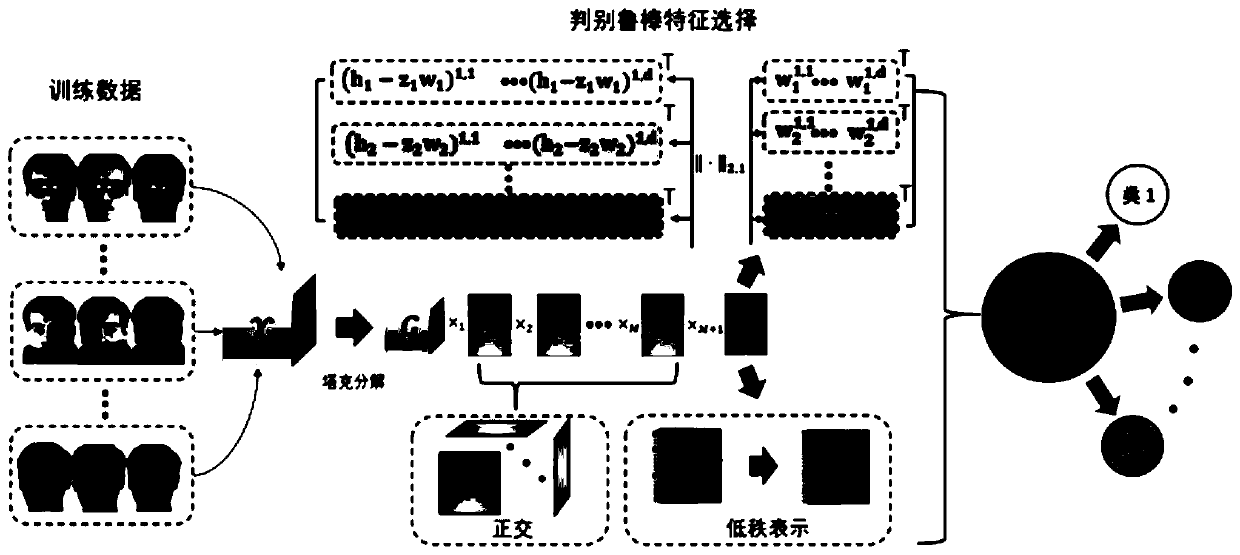Image classification method based on heterogeneous tensor decomposition
A technology of tensor decomposition and classification method, applied in the field of image classification based on heterogeneous tensor decomposition, can solve the problems of losing structural information and destroying element dependencies, and achieves the effect of improving the discrimination ability and the classification accuracy.
- Summary
- Abstract
- Description
- Claims
- Application Information
AI Technical Summary
Benefits of technology
Problems solved by technology
Method used
Image
Examples
Embodiment 1
[0035] An embodiment of the present invention provides an image classification method based on heterogeneous tensor decomposition, see figure 1 , the method includes the following steps:
[0036] 101: Construct the original tensor according to the ORL dataset;
[0037] Wherein, the ORL data set is a face image database established by the University of Cambridge, UK, which is well known to those skilled in the art, and will not be described in detail in this embodiment of the present invention.
[0038] 102: Decompose the original tensor into a factor matrix and a sample feature representation matrix corresponding to each order of the tensor;
[0039] 103: Add column-by-column orthogonal constraints on the factor matrix;
[0040] 104: Apply a low-rank constraint to the sample feature representation matrix Z, and obtain the lowest-rank representation by identifying the global low-rank structure of the sample;
[0041] 105: pass l 2,1 Norm-constrained loss function and regulariz
Embodiment 2
[0047] The scheme in embodiment 1 is further introduced below in conjunction with specific calculation formulas and examples, see the description below for details
[0048] 1. Problem definition
[0049] Suppose a target tensor of order M is given The training set of , where N is the number of samples, I 1 × I 2 ×…×I M is the size of the sample space, and R is the real sample space. Combine N target tensors into a tensor of order (M+1) At the same time, F=[f 1 , f 2 ,..., f N ] T ∈{0,1} N×C Represented as a binary label matrix, where C is the number of classes and f i is the i-th sample χ i The label vector for . if and only if χ iWhen belonging to the jth category (j=1, 2,..., C), the element f i,j is 1, and the rest are 0.
[0050] The proposed algorithm aims to jointly learn:
[0051] 1) For the first M order of the tensor, learn M orthogonal factor matrices Realize the low-dimensional embedding of the original tensor, and learn the feature representation m
Embodiment 3
[0096] Below in conjunction with concrete implementation process, implementation result, carry out feasibility verification to the scheme in embodiment 1 and 2, see the following description for details:
[0097] Comparing our method with state-of-the-art classification algorithms to validate the joint use of kernel tensors and l 2,1 The effectiveness of heterogeneous tensor decomposition of norms for image classification, the data set used is: ORL.
[0098] In Example 1, the proposed heterogeneous tensor decomposition based image classification is evaluated on the widely used dataset ORL. This dataset has been widely used by various image classification methods. Apply nearest neighbor classifiers to evaluate classification performance.
[0099] The ORL dataset contains 40 different subjects, each with 10 images. Images in the same subject were taken with wide variance, changing lighting, facial expressions (eyes open / closed, smiling / unhappy) and facial details (glasses /
PUM
 Login to view more
Login to view more Abstract
Description
Claims
Application Information
 Login to view more
Login to view more - R&D Engineer
- R&D Manager
- IP Professional
- Industry Leading Data Capabilities
- Powerful AI technology
- Patent DNA Extraction
Browse by: Latest US Patents, China's latest patents, Technical Efficacy Thesaurus, Application Domain, Technology Topic.
© 2024 PatSnap. All rights reserved.Legal|Privacy policy|Modern Slavery Act Transparency Statement|Sitemap



